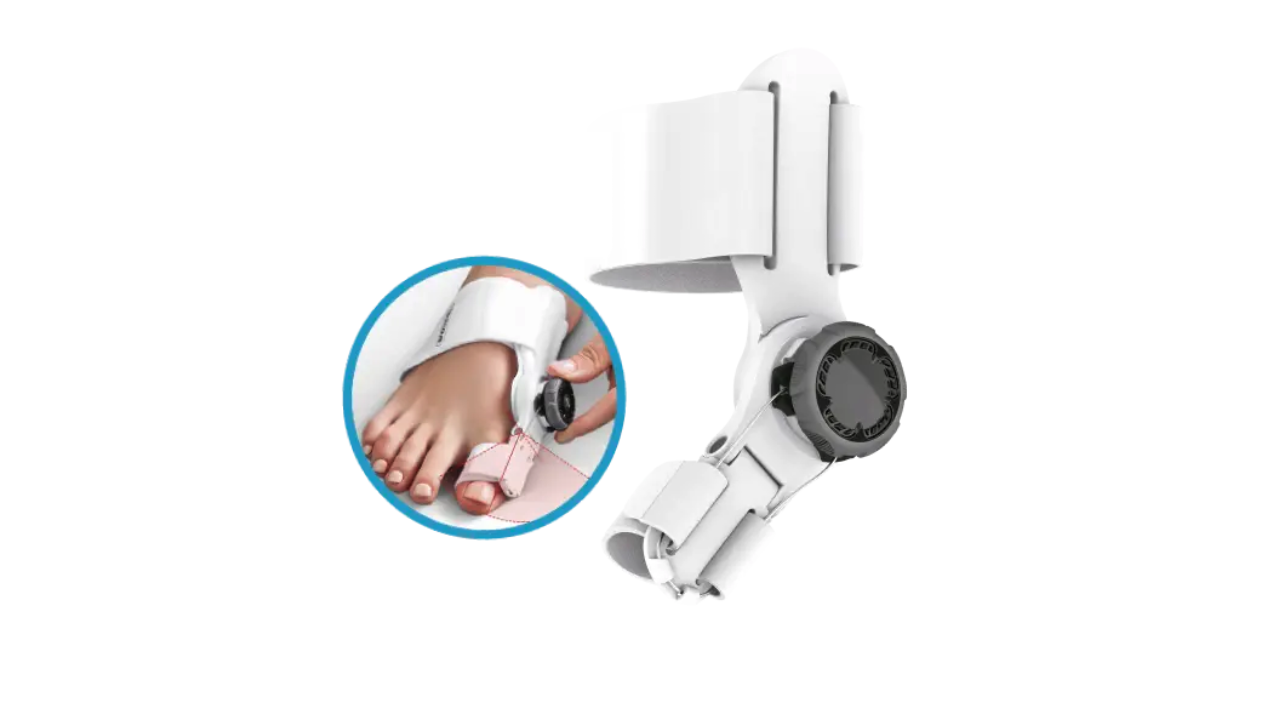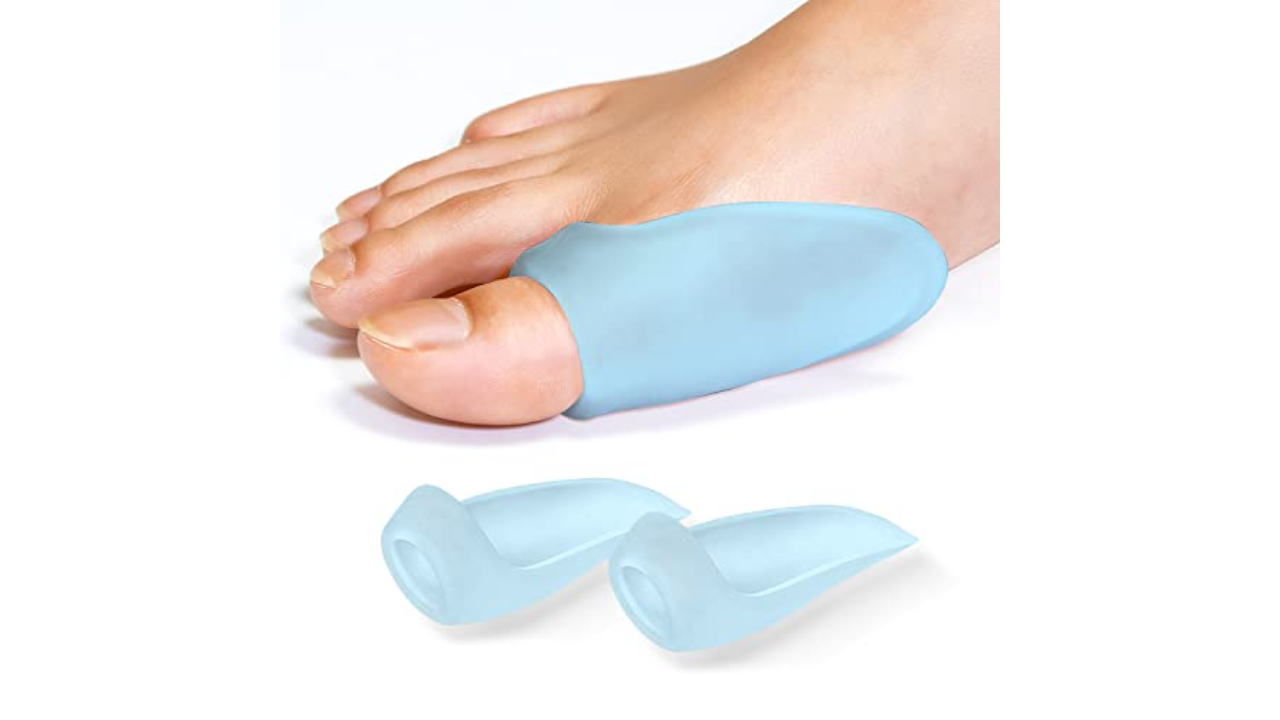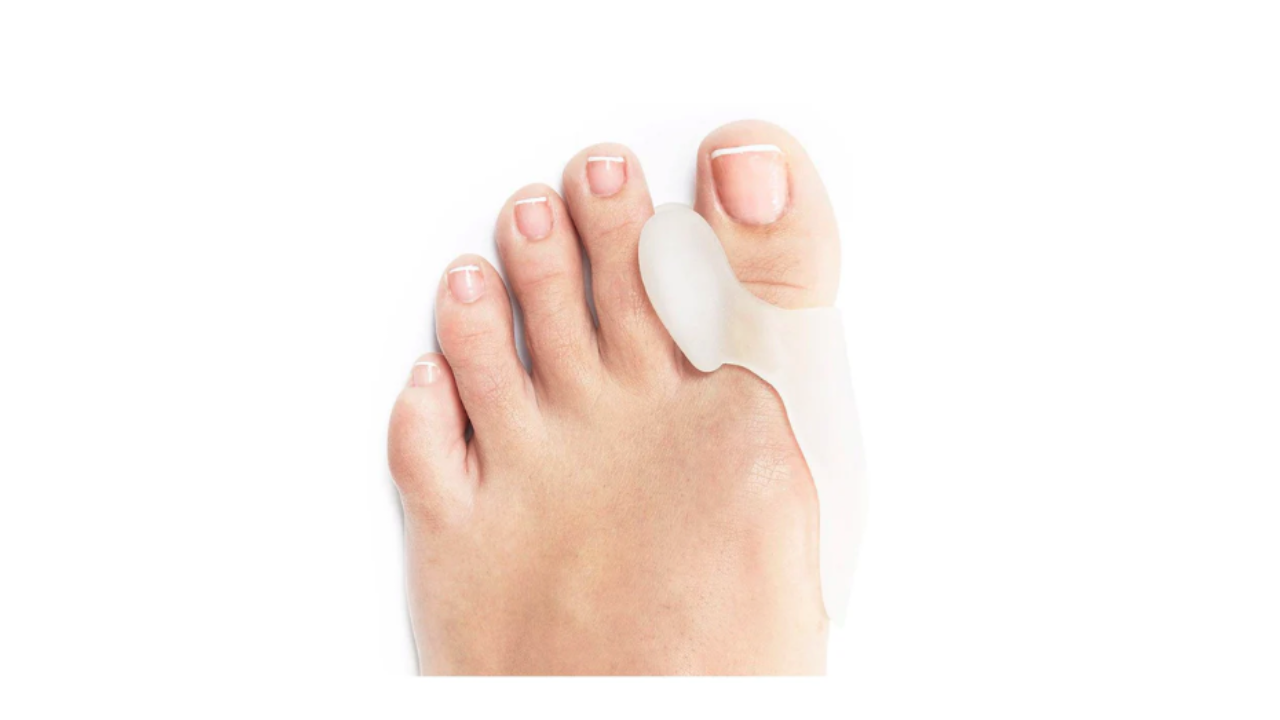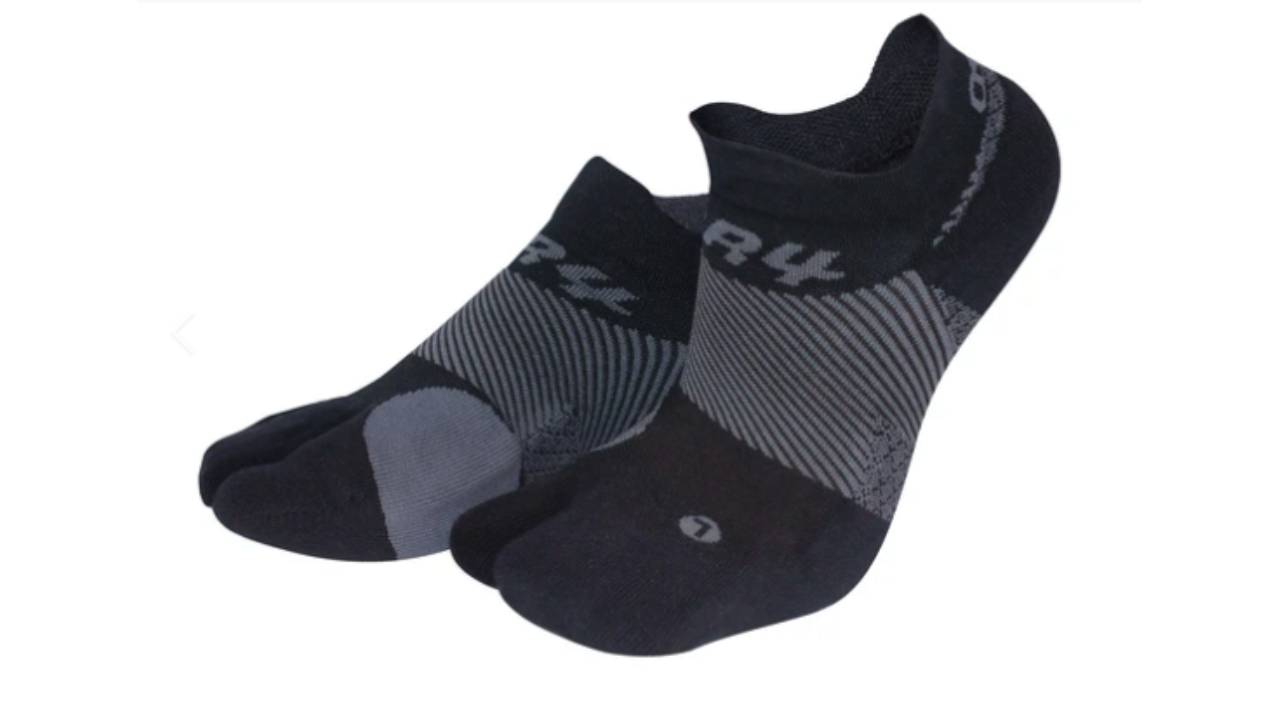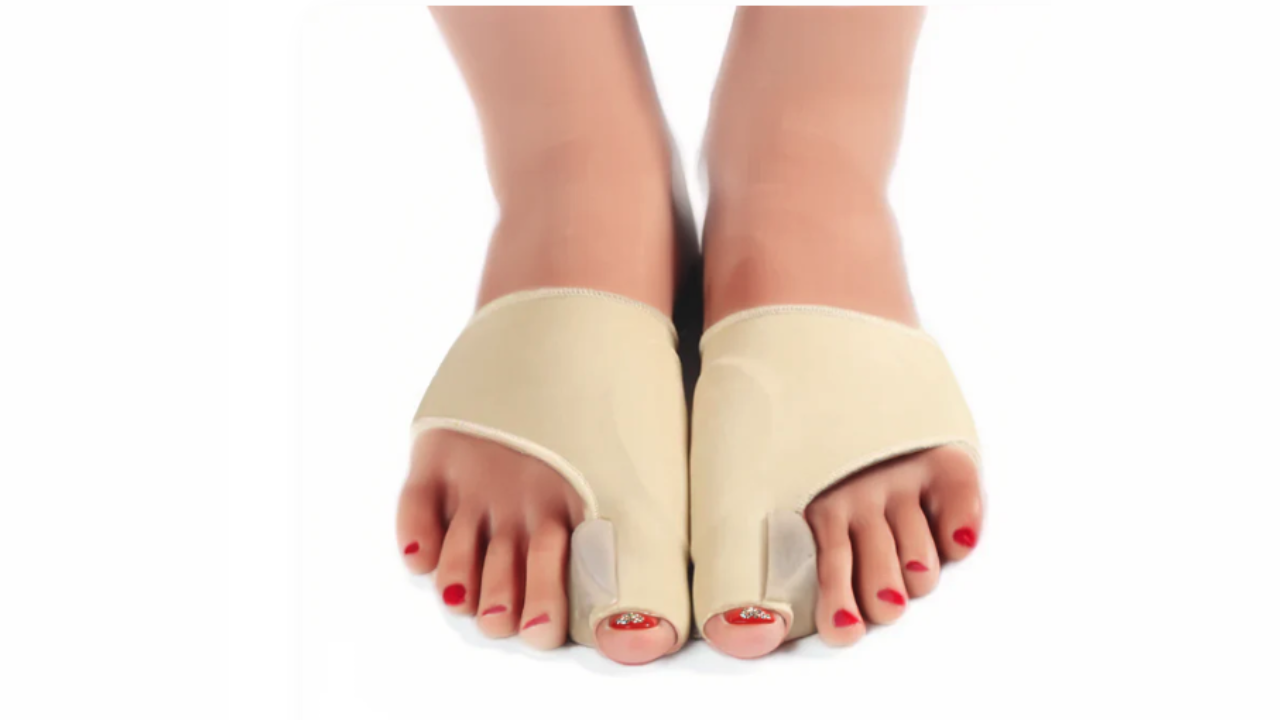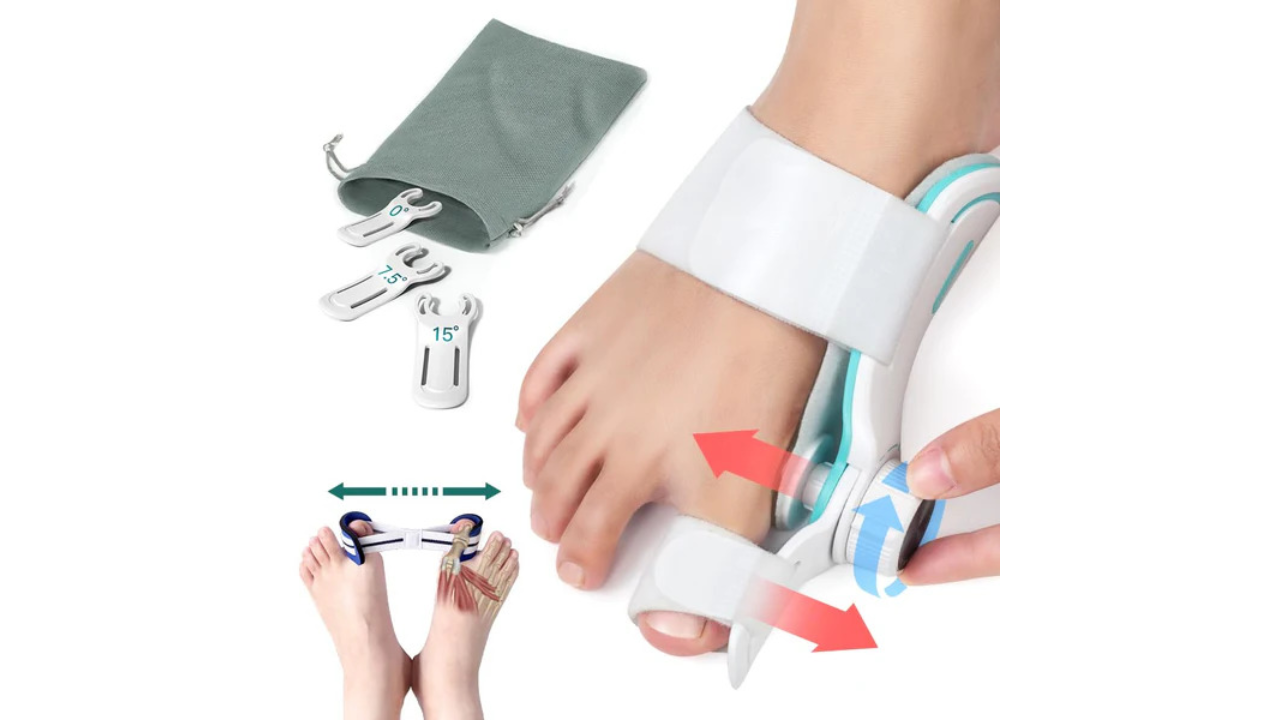
We independently evaluate the products we review. When you buy via links on our site, we may receive compensation. Read more about how we vet products and deals.
The best bunion correctors for 2024, according to podiatrists
Realign your toes and get pain relief with bunion correctors and other products from Bunaline, NatraCure, Dr. Scholl's, Skechers and more.

Got bunions? You're not alone. A bunion, also known as a hallux valgus (HV), is a type of foot deformity, but it's a common one. By age 65, one in three people have bunions, experts estimate. And if you're a biological female, wear tight or narrow shoes or high heels, or have parents with bunions you're more likely to deal with these painful, unsightly foot bumps.
Bunaline bunion corrector
Best overall bunion corrector
Promifun Bunion Cushions and Protector
Best bunion guard
NatraCure Gel Big Toe Bunion Guard with Toe Spreader
Best toe spreader for bunions
Dr. Scholl's Bunion Relief & Toe Corrector
Best for nighttime use
Aetrex Premium Memory Foam Orthotics
Best insoles for bunions
OS1st Bunion Relief Socks
Best socks for bunions
Emily's Ergonomic Bunion Corrector
Best sleeve for bunions
Dr. Frederick's Original Bunion Pad & Spacer Kit
Best bunion kit
Skechers D'Lites Fresh Start
Best shoes for bunion correction
Tenicore XH Big Toe Adjustable Knob Bunion Corrector
Best adjustable bunion corrector
A bunion occurs when the soft tissue in the foot swells over the inside edge of the big toe joint, explains Jeremy Ousey, a musculoskeletal podiatrist in the U.K. Due to instability in the mid-foot joint where the toes attach, the big toe starts moving away from the other bones in the foot, leading to a bunion.
Bunions can be permanently fixed only with surgery, but not everyone with bunions needs surgery. Some people can manage the condition with bunion correctors, which can help better align the toes and relieve bunion pain and discomfort. "Bunion correctors can be an effective treatment option, especially with a mild to moderate, flexible bunion deformity," says Dr. Craig Radnay, an orthopedic surgeon with the Florida Orthopedic Institute in partnership with Tampa General Hospital. "A bunion that is flexible or 'moveable' can be straightened manually or held temporarily with a corrector."
In certain cases, bunion correctors can also prevent bunions from getting worse. Plus, bunion correctors can be worn post-bunion surgery to encourage healing.
If you develop bunions or your bunions become more painful, talk to a podiatrist. These foot specialists can suggest a full treatment plan, which may include using a bunion corrector or other supportive device. We interviewed five podiatrists and a footwear design expert to better understand bunion correctors and recommend the best bunion correctors you can try.
Table of contents
The best bunion corrector overall
Cost: $138 | Type: Silicone daytime corrector | Sizing: N/A | Adjustable: Yes | Arch support: No
We chose the Bunaline as our overall best pick for its comfort, adjustability and flexibility of use for a variety of feet. "Bunaline is silicone, so it's comfortable, fits all sizes and works for men and women," Radnay says.
A 2021 systematic review of bunion correctors found that to be effective, a bunion corrector needs both a toe separator and a mechanism for keeping the foot aligned properly — both of which the Bunaline has.
As Radnay points out, the silicone pad helps make the bunion correction process more comfortable. (As you might imagine, it's not necessarily pleasant to force your toe to move in a new direction.) And because its knob is fully adjustable, the corrector can be used on all foot sizes (and can even be switched from one foot to the other). It allows for natural toe movement while ensuring the big toe moves into the correct alignment, which is essential for relieving bunion pain.
The Bunaline also comes with a lot of positive reviews. "I've been using bunion correctors for many years, and this is the best one I've ever had," wrote one user. "It can be kept at home for walking, resting on the sofa and for sleeping, it always stays in position."
- Adjustable
- Comfortable
- One size fits all
- No arch support
Other top bunion correctors we recommend for 2024
Cost: $10 | Type: Bunion guard | Sizing: N/A | Adjustable: No | Arch support: No
As a bunion guard or shield, the Promifun works to subtly separate the big toe from the rest of the toes while cushioning the bunion to help reduce friction and pain. Radnay says that Promifun bunion products are not as rigid as Bunaline's, so they won't be suitable for large corrections.
Instead, the Promifun bunion guard can be used as a simple, budget-friendly solution for new or mild bunions, or can be used in conjunction with other correction methods. For instance, it can be worn with bunion socks or sleeves, or even a bunion corrector. A 2019 study also notes that bunion shields are effective for reducing pain and discomfort from bunions.
The main appeal of the bunion guard is that it can be worn anywhere and it can be reused and washed if necessary. "It's low profile and fits easily in shoes," Radnay adds.
- Affordable
- Reusable
- Can be used any time
- Cushion only
- Not a corrector
Cost: $10 | Type: Gel spreader | Sizing: N/A | Adjustable: No | Arch support: No
Dr. Gregory Alvarez, a podiatrist at Ankle & Foot Centers of America in Fayetteville, Ga., says this NatraCure product is effective thanks to its combination of cushioning and gentle toe separation. "It's well-designed to alleviate discomfort and fit easily into most routines," he adds.
This gelled toe spreader provides necessary toe separation for bunion pain relief, but it also releases medical-grade mineral oil (USP), vitamin E and aloe vera for skin protection and comfort while you're wearing it.
"They are very comfortable for daily all-day wear and sized well for my feet (women's size 7.5 US)," reports one reviewer. "They seem pretty durable, and although I do not do much daily walking, I have gone on some day hikes with them."
- Can be worn all day
- Washable and reusable
- Stretchy
- Material may rub between toes
- One size fits most (not all)
Cost: $17 | Type: Gel splint | Sizing: N/A | Adjustable: Yes | Arch support: No
Dr. Scholl's claims that its nighttime bunion corrector has been clinically shown to be effective for reducing pain and bunion progression. These night splints are fully adjustable, meaning you wrap the fastener around your toe and tighten it to your comfort level.
We couldn't locate the Dr. Scholl's study, but we did find a 2021 study review that points out that night splints for bunions are designed to keep the toes in alignment while being non-weight-bearing. The study found that some pain relief was experienced by participants who used night splints but added that night splints were most effective when used in conjunction with other interventions (like exercise while using a toe separator and dry needling) to help reduce the angles of the hallux valgus and intermetatarsals.
Regardless, wearing a night corrector for bunions is a bit of a no-brainer because it's an effortless way to reduce pain and slow bunion growth. Because nighttime bunion correctors are non-weight-bearing and don't need to fit in a shoe, they can also be made of softer, less rigid materials that are more comfortable to sleep in. (Note: As a general rule, don’t wear them for over eight hours, even if you're sleeping.)
- Velcro adjustable
- Comfortable
- Can be worn all night
- No rigidity
- Best for mild bunions
Cost: $80 | Type: Foam insoles | Sizing: 5-13 (women's) | Adjustable: No | Arch support: Yes
Orthopedic footwear designer Liza Egbogah recommends these orthotics from Aetrex because they have a deep heel cup to control overpronation, arch support and cushioning under the metatarsals.
"Bunions are aggravated when you overpronate (ankles rolling in when you walk) so by wearing supportive insoles that reduce overpronation, bunions will be less inflamed," Egbogah explains. "The right insoles can also help prevent your bunions from getting worse. The insole should have ample arch support, metatarsal pads and cushioning."
- Cup heel
- Memory foam
- Antimicrobial
- Not moldable
- More expensive than other insoles
Cost: $25 | Type: Bunion socks | Sizing: S, M, L | Adjustable: No | Arch support: No
Bunion socks that help align the big toe while providing some arch support and cushioning can offer pain relief and slow bunion formation, Egbogah says. "A key feature to look for is that the sock creates some space between the first and second toes," she notes.
She recommends these socks from OS1st as well as Sockwell bunion socks, as they each provide compression to ease inflammation while supporting and helping align the big toe.
- Medical grade compression
- Antimicrobial
- Split-toe design
- Ankle length only
- Gentle wash only
Cost: $20 | Type: Splint sleeve | Sizing: N/A | Adjustable: Yes | Arch support: No
Recommended by Dr. Shital Sharma, a podiatrist with Pinewood Family Care LuxStep Concierge Podiatry, this bunion corrector is a bunion splint with the comfortable design of a sleeve. The sleeve fits over the top of your foot (much like a sock) and comes with an adjustable strap that you can tighten or loosen over your toe as needed, depending on your bunion size.
"It's incredibly soft and comfortable to wear, and I love that it's washable and reusable," said one shopper. "Plus, the discreet design makes it easy to wear throughout the day without anyone noticing. Highly recommend!"
- Comfortable design
- Washable
- Can be worn all day
- Not just a sleeve alone
- One size only
Cost: $11 | Type: Toe spacers | Sizing: N/A | Adjustable: No | Arch support: No
Dr. Sidney Weiser, a podiatrist and CEO of Quality Podiatry Group, explains that a bunion kit allows you to pull over the big toe, either by using a toe spacer or a sleeve that fits over your big toe, splinting it into a straight alignment. He adds that choosing a bunion kit with a gel pad for extra padding around the bunion site can help decrease friction from shoe gear.
Alvarez recommends the Dr. Frederick's kit "because it includes a variety of pads and spacers to accommodate different needs and footwear." The kit is a bit of a "one-stop shop" for bunion pain, coming with four different types of bunion pads, spacers and toe separators in multiple sizes and shapes. The kit includes a shield spacer, which is a larger bunion pad that loops around the big toe and is meant to be worn with shoes; a standard spacer, a lighter spacer that can be worn without shoes on the second toe; a sport shield spacer, a stretchy shield and spacer designed to keep the toe in place during active periods; and a sport spacer, a lighter spacer that loops around the big and second toes that can be worn without shoes.
Reviewers say the kit can be especially helpful for active people with bunions. "Hoping to find some relief in my downtime, I turned to these post-run," wrote one user. "They give me the perfect spread between my toes while still allowing me to move around the house. I am also on my feet all day at work and love a little extra support in regards to that as well!"
- Offers multiple sizes
- Includes 3 different products
- Good for pain relief
- Not adjustable
- Not a full corrector
Cost: $80 | Type: Shoe | Sizing: Extra wide | Adjustable: Yes | Arch support: Yes
If you have bunions, it's best to look for wide shoes and a large toe box, Radnay says. The extra room provides space not only for comfort — preventing pain caused by a bunion rubbing against your shoe — but also allows you to wear bunion correctors to improve toe alignment.
Any shoe with a wide toe box can work, but Maryann McMurty, a teacher from Michigan who had bunions for years before undergoing surgical correction, says she was a big fan of Skechers sneakers because they have a naturally wide design and come in extra-wide sizes. She also found that choosing a shoe with bridge support helped her bunions.
Egbogah also recommends Kuru Atom sneakers for bunion correction and New Balance 608v5 classic trainers thanks to their roomy toe box, stable midsole, shock absorption and ability to accommodate orthotic insoles. Egbogah adds that if you want a non-sneaker, look for leather. "The leather can adapt to your foot and give you a custom fit," she says.
- Extra-wide toe box is more comfortable
- Adjustable laces for a better fit
- Memory foam cushioning
- Heel may be too high for some people with bunions
- Limited color options
Cost: $70 | Type: Corrector | Sizing: 11 inches (women's); 13 inches (men's) | Adjustable: Yes | Arch support: No
Radnay recommends this Tenicore bunion corrector because it is "adjustable, sturdy and easy to use." It has a full top-of-the-foot design and a large knob that you can use to obtain a custom fit. It comes with visual instructions that are easy to follow.
The corrector is also ideal if you're not sure what size you need — it comes in 11- and 13-inch sizes (typically in correlation to women's or men's foot sizes) as well as three different toe adjuster plates. The brand recommends wearing its corrector for a minimum of two hours at a time, twice a day.
- 60-day money-back guarantee
- Highly adjustable
- Online user support
- More expensive than other options
- No website reviews
Types of bunion correctors
Radnay says that all bunion correctors apply gentle pressure to hold the toe straight. "These are non-invasive devices that can help with discomfort and slow the progression of the bunion deformity," he says.
While all bunion correctors apply pressure, they vary in the degree of pressure and support, how they are meant to be worn (daytime vs. nighttime, for instance) and design. Some bunion correctors can also work together, like a guard and a corrector, for instance.
Radnay notes that once the pressure of a bunion corrector is removed, the bunion deformity will recur. He recommends consulting with a podiatrist as soon as you notice a bunion forming. A doctor may be able to recommend a full treatment plan that could include bunion correctors.
Here are different types of bunion correctors you might consider:
Bunion splints: These rigid or semi-rigid devices are worn at night to keep the big toe in a more natural position while you sleep.
Bunion sleeves and pads: These removable soft cushions can be worn during the day in shoes to reduce friction and pressure from shoes.
Bunion-correcting toe spacers: These separate the big toe from the second toe to provide pain relief and keep the toes in alignment.
Bunion relief arch supports: These insoles are worn with shoes to support and cushion the arch of the foot and can help correct the foot mechanics that contribute to bunion formation.
Bunion relief socks: These socks typically have built-in padding to provide relief from pressure and friction.
Bunion relief shoes: While they may not correct bunions, shoes designed to be worn with bunions typically have wider toe areas to prevent pain and further discomfort.
Factors to consider when choosing a bunion corrector
It can be helpful to look for the following features when choosing a bunion corrector:
Comfort: The bunion corrector should be comfortable to wear — it should not cause additional pain or discomfort.
Durability: Bunion correctors are worn on your feet, so you'll want something that can withstand daily use.
Easy to use: The corrector should be easy to put on, take off and clean.
Fit: It should fit well with your foot shape and be adjustable if needed. Radnay recommends choosing a low-profile, semi-rigid bunion corrector because it can help correct the toe deformity while still being comfortable enough to wear.
Flexibility: The corrector should accommodate different types of footwear if you wear it during the day. Some degree of flexibility is helpful so that it fits into your shoe.
It's important to remember that despite the name, a bunion corrector will not permanently correct bunions. A bunion corrector can help relieve pain and discomfort and may stop bunions from getting worse, however.
For some people, that's enough. But for bunions that are causing severe pain or interfering with daily life, talk to a podiatrist about your options. If you do need surgery, there are effective options, Radnay says.
"Fortunately, we now have excellent, new minimally invasive surgeries that cause less pain, have quicker recovery, and yield great outcomes in terms of deformity correction, pain relief and resumption of activity," he says.
How we chose the best bunion correctors
To choose the best bunion correctors and footwear products for bunions, we interviewed five podiatrists and one footwear designer to gain insight into the best brands and features, and, in some cases, get product recommendations. We checked over 30 different products to compile expert-backed recommendations along with product picks that aligned with our research. We also considered factors like price, effectiveness and user reviews when evaluating each bunion corrector.
FAQs
Do bunion correctors really work?
Bunion correctors can relieve pain and discomfort in the early stages of bunion formation. They may also slow the progression of bunions. However, they are not a cure, and chronically painful bunions or those that worsen will need treatment by a doctor.
How long does it take for a bunion corrector to work?
Some people may notice immediate relief with a bunion corrector, while others may need several weeks to allow their toe alignment to shift. A bunion corrector must be used consistently to see results.
Can I wear a bunion corrector all day?
"The more regularly you wear a bunion corrector, the more effective it can be. Most bunion correctors are worn for at least two to three hours a day and sometimes overnight," says Radnay. If you wear a nighttime bunion corrector, however, be sure to switch it out for a daytime one, as night-wear correctors can be too bulky for daytime use.
Are bunion correctors covered by insurance?
Bunion correctors are not usually covered by insurance because they can be purchased over the counter. That said, you may be able to use HSA or FSA funds to cover the expense. If you need specialized bunion products, talk to your doctor.
When to see a doctor
Radnay suggests seeing a doctor as soon you notice a bunion forming, because the earlier you intervene, the less likely you are to have complications. "Once you start noticing an increasing deformity or 'bump' along the inside part of your foot, consider seeking consultation," he says. "Ideally, you start treatment early to help slow down progression and to minimize limitations on activities you enjoy. Even if the bunion eventually requires surgical correction, the surgery might be less complex and not involve additional surgery on deformities of the other toes caused by the bunion."
You should also see a doctor if your bunion is causing severe pain, worsening or interfering with daily life.
Meet our experts
Gregory Alvarez, DPM, FACFAS with Ankle & Foot Centers of America in Fayetteville, Georgia
Liza Egbogah BSc, DC, DOMP, orthopedic footwear designer
Jeremy Ousey, a musculoskeletal podiatrist based in Swansea, U.K.
Craig Radnay, MD, MPH, board-certified, fellowship-trained orthopedic surgeon with Florida Orthopedic Institute in partnership with Tampa General Hospital
Shital Sharma, DPM with Pinewood Family Care LuxStep Concierge Podiatry in New Jersey
Sidney Weiser, DPM, CEO of Quality Podiatry Group












